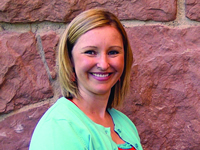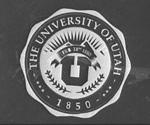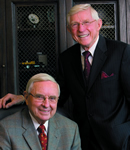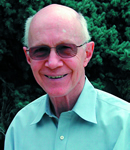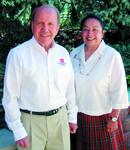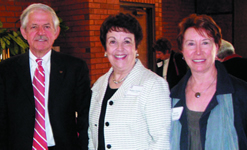Merit of Honor Awards Recognize Five U Alumni

This year’s Merit of Honor Award winners are, from left, Marian Watkins Ingham BS’63, Beth S. Jarman BS’64 MS’70 PhD’77, Kay Atkinson King BA’64, Mike Korologos BS’59, and Ted L. Wilson BS’64.
The University of Utah Emeritus Alumni Board selected five exemplary alumni to be honored with its 2011 Merit of Honor Awards. The annual awards recognize U alumni who graduated 40 or more years ago and whose careers have been marked by outstanding service to the University, their professions, and their communities.
This year’s winners are Marian Watkins Ingham BS’63, Beth S. Jarman BS’64 MS’70 PhD’77, Kay Atkinson King BA’64, Mike Korologos BS’59, and Ted L. Wilson BS’64. The Emeritus Alumni Board hosted a banquet to recognize them on Nov. 2 at Rice-Eccles Stadium & Tower.
Ingham was the owner/operator of American Icon Products Co. and a sales representative for Midwest of Cannon Falls, Arthur Court Designs, and Compendium
for more than 25 years. She was chair of the Health Sciences Educational Resource Development Council and now serves on its board and on the Fine Arts Advisory Board for the Huntsman Cancer Institute, the Pharmacy Ambassadors Advisory Council, and the Kingsbury Hall Board.
Jarman has long promoted quality education and equality and has been active in government service. As a member of the Utah House of Representatives, she served as a member of the Women’s Political Caucus and chair of the Committee to Study Discrimination in Utah’s Laws. She later became chair of the Utah Housing Finance Agency Board of Directors, and she was the first woman executive director of the Utah Department of Community Affairs. She was also director of Arizona’s Department of Commerce. She is currently president and CEO with The Farsight Group, a consulting company that works with executives and boards to create innovations and design organizational change strategies.
King has long been active in national government administration, working with members of Congress since 1984, most recently as director of InterParliamentary Affairs for the U.S. House of Representatives from 2007 to 2010. She then became a principal of The Podesta Group, a Washington, D.C.-based lobbying and public relations firm. She previously served as Democratic Senior Policy Advisor for the House Committee on Foreign Affairs.
Korologos’s career includes 25 years as sports writer, columnist, editor, and newsroom executive for The Salt Lake Tribune; 30 years as a regional correspondent for Skiing magazine; 14 years with Evans Advertising; and 10 with Reuters News Service. He served as communications director for the Bid and Organizing committees of the 2002 Winter Olympics and is now a public-relations consultant for RIESTER. Korologos is immediate past chair of the J. Willard Marriott Library National Advisory Board and is a member of the library’s Ski Archives Advisory Board. He also serves as a member of the president’s cabinet for the U’s “Together We Reach” campaign.
Wilson served as mayor of Salt Lake City from 1976 to 1985. He was the director of the U’s Hinckley Institute of Politics for 18 years and was the founding director of the Tanner Center for Nonviolent Human Rights Advocacy. He founded Exoro Co. and currently serves as director of government affairs for Talisker Corp. A professor emeritus of political science, he continues to teach classes at the U and is a member of the College of Social and Behavioral Science Advisory Board.
U Alumni Contacts Serve as International Network

University of Utah alumni now have a network of fellow graduates in many countries around the world. Twenty-one alumni from 18 countries, plus alumni club officers in three more nations, have agreed to serve as international alumni contacts.
The 21 alumni either now live in or maintain ties to their home countries of Brazil, Canada, Costa Rica, Egypt, England, Germany, Jordan, Morocco, Nepal, Oman, Poland, Portugal, Romania, Russia, Rwanda, Saudi Arabia, Turkey, and Ukraine.
In addition, University of Utah graduates who are officers of alumni clubs in China, Europe, India, and Taiwan serve as U liaisons in their home countries.
These international contacts help by:
- Being a source for newly admitted U students from their country and being available for parents and/or students if they have questions about the University
- Working closely with the University of Utah and the U’s International Center to host distinguished visitors to their region
- Serving as contacts for other alumni visiting their country
- Reaching out to newly graduated U students returning to their country
- Assisting with fairs and other events by representing the U in their country
For biographies of these international alumni contacts, please visit the international alumni Web site at http://ic.utah.edu/alumni/contacts.htm and click on the U icons on the map.
If you want to become an international alumni contact for your country or to reach any of our international alumni, please e-mail icalumni@ic.utah.edu.
Alumni Fall Football Social Draws Crowd of 200
Photos by Nathan Sweet

Most of the new members of the University of Utah Alumni Association’s Board of Directors attended the annual Fall Football Social in September at the Alumni House. They are, from left, Julie Barrett BA’70, Lewis Dickman BS’75, Lindsey Ferrari BA’87, Vicki Mortensen BS’72, and Craig Stagg BSN’83.

University of Utah Head Football Coach Kyle Whittingham speaks about Utah’s debut season in the Pac-12.
With the University of Utah Marching Band playing, about 200 U alumni, students, and staff members sat down for a casual dinner Sept. 6 at the annual Fall Football Social on the Alumni House patio, waiting for the opportunity to hear U Head Football Coach Kyle Whittingham speak about Utah’s debut season in the Pac-12.
The attendees included many of the new members of the U Alumni Association’s Board of Directors: Julie Barrett BA’70, Lewis Dickman BS’75, Lindsey Ferrari BA’87, Vicki Mortensen BS’72, and Craig Stagg BSN’83. (New directors Jeff Cardon BS’80 and Tom Cloward BA’87 were unable to be there.)
Whittingham, accompanied by quarterback Jordan Wynn and linebacker Chaz Walker, spoke briefly about Utah’s strategies heading into their first Pac-12 game, against the University of Southern California, in Los Angeles. (The Utes went on to lose that one, 23-14, and then trounced BYU the following week, 54-10.)
The coach also noted that the U’s entry into the Pac-12 this year has already started to boost recruiting for the University’s football team. “We felt that spike in recruiting right away,” he said. “Recruiting has gone up, and it’s got to go up, because everyone in the Pac-12 is a little bit bigger, a little bit faster, a little bit stronger than what we’ve been facing in the last years, and so we have to subsequently recruit at a high level to keep pace with that.”
Homecoming Events Net $50,000 for Scholarships
Photos by Christopher Reeves

Runners compete in the Homecoming Young Alumni 5K.

Students watch fireworks during Homecoming.
The University of Utah Alumni Association’s fundraising events during Homecoming Week generated nearly $50,000 for U scholarships for deserving students.
Homecoming Week began Saturday, Sept. 24, when scores of volunteers turned out to participate in the Legacy of Lowell Community Service Day. The following Tuesday, campus groups decorated their areas to reflect this year’s Homecoming theme, “Pac to the Future.” The U’s emeritus alumni—those who graduated 40 or more years ago—gathered for their Homecoming reunion Tuesday evening, with a dinner and exhibit tour of “LeConte Stewart: Depression Era Art” at the Utah Museum of Fine Arts.
Fraternity and sorority members competed in song and dance at Songfest on Thursday, and that was followed by a pep rally at the Union Building. Friday began with the U Alumni Association hosting the Homecoming Scholarship Scramble, a golf tournament at Bonneville Golf Course. The golf tournament netted about $20,000 for U scholarships.
Friday night, students gathered for the annual Homecoming dance, held at The Depot at The Gateway shopping center in Salt Lake City.
The Young Alumni 5K and Kids 1K Fun Run on Saturday morning, Oct. 1, raised about $30,000 for U scholarships. The crowds headed in the direction of Rice-Eccles Stadium in the afternoon for the Alumni Association’s pre-game tailgate party on Guardsman Way and then watched the Utes play the Washington Huskies in the U’s first home game in the Pac-12.

Alumni Board President Keven Rowe competes in the golf tournament.

Emeritus alumni eat dinner at their reunion at the Utah Museum of Fine Arts.

Swoop leads the pack in the Kids 1K Fun Run.
 Esther Fujimoto ex’91, a University of Utah scientist who was on the team that helped discover a breast cancer gene, died August 21 after being hit by a power boat while swimming in Pineview Reservoir near Ogden. She was 49.
Esther Fujimoto ex’91, a University of Utah scientist who was on the team that helped discover a breast cancer gene, died August 21 after being hit by a power boat while swimming in Pineview Reservoir near Ogden. She was 49. Billings Witbeck BS’57, a longtime University of Utah manager in education administration, died August 20 at his home outside of Rexburg, Idaho. He was 82.
Billings Witbeck BS’57, a longtime University of Utah manager in education administration, died August 20 at his home outside of Rexburg, Idaho. He was 82.
 The University of Utah has been engaged in a vigorous capital campaign—dubbed “Together We Reach: The Campaign for the University of Utah”—since 2005. Thanks to the overwhelming generosity of many U of U alumni and friends during the last six years, the campaign has been extraordinarily successful and is edging closer to its $1.2 billion goal, with two years remaining.
The University of Utah has been engaged in a vigorous capital campaign—dubbed “Together We Reach: The Campaign for the University of Utah”—since 2005. Thanks to the overwhelming generosity of many U of U alumni and friends during the last six years, the campaign has been extraordinarily successful and is edging closer to its $1.2 billion goal, with two years remaining.












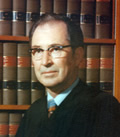 Cameron M. Batjer JD’50, a former justice of the Nevada Supreme Court who later served on the U.S. Parole Commission, died June 1 at his home in Reno surrounded by family. He was 91.
Cameron M. Batjer JD’50, a former justice of the Nevada Supreme Court who later served on the U.S. Parole Commission, died June 1 at his home in Reno surrounded by family. He was 91. Garry Shirts BS’58 MS’63 PhD’68, an educational psychologist and pioneer in the simulation training field, died of a heart attack April 23 in Del Mar, Calif. He was 77.
Garry Shirts BS’58 MS’63 PhD’68, an educational psychologist and pioneer in the simulation training field, died of a heart attack April 23 in Del Mar, Calif. He was 77. Richard “Dick” Grow BS’48 MS’49, a professor and former chair of the University of Utah’s Department of Electrical Engineering and a pioneer in technology development, died June 8. He was 85.
Richard “Dick” Grow BS’48 MS’49, a professor and former chair of the University of Utah’s Department of Electrical Engineering and a pioneer in technology development, died June 8. He was 85. Michael K. Young, the 14th president of the University of Utah, who has led the University since 2004, has accepted the position as president of the University of Washington.
Michael K. Young, the 14th president of the University of Utah, who has led the University since 2004, has accepted the position as president of the University of Washington. The State Board of Regents approved a 5 percent increase in tier one tuition for all Utah System of Higher Education institutions. Combined with a requested 2.8 percent tier-two increase, the cost of attending the University will grow by 7.8 percent in 2011-12. Revenue from the tier-one increase will be used primarily to cover the rise in health insurance premiums for U of U employees and to provide some funds for selective salary upgrades. Revenue from the tier-two increase will be used to address a variety of needs in academic, service, and administrative areas. Tuition increases ranged from 5 to12 percent in schools throughout the state.
The State Board of Regents approved a 5 percent increase in tier one tuition for all Utah System of Higher Education institutions. Combined with a requested 2.8 percent tier-two increase, the cost of attending the University will grow by 7.8 percent in 2011-12. Revenue from the tier-one increase will be used primarily to cover the rise in health insurance premiums for U of U employees and to provide some funds for selective salary upgrades. Revenue from the tier-two increase will be used to address a variety of needs in academic, service, and administrative areas. Tuition increases ranged from 5 to12 percent in schools throughout the state.

 As part of its ongoing effort to encourage green transportation, the University’s Commuter Services has installed two bicycle repair stands on campus, located by the bicycle collective in the business loop and at the southwest corner of the Olpin Student Union. These repair stations are the first of their kind on campus, and other locations are being studied for additional stands, which provide tools for the maintenance of bicycles, including air pumps and other basic equipment. For the past few years, Commuter Services has promoted cycling to campus as a convenient, healthy, and “green” alternative to driving.
As part of its ongoing effort to encourage green transportation, the University’s Commuter Services has installed two bicycle repair stands on campus, located by the bicycle collective in the business loop and at the southwest corner of the Olpin Student Union. These repair stations are the first of their kind on campus, and other locations are being studied for additional stands, which provide tools for the maintenance of bicycles, including air pumps and other basic equipment. For the past few years, Commuter Services has promoted cycling to campus as a convenient, healthy, and “green” alternative to driving.









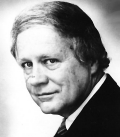 Hays Gorey BA’42, a distinguished newsman, died April 5. He was 89.
Hays Gorey BA’42, a distinguished newsman, died April 5. He was 89. Anne Riordan BS’56, a pioneer in dance and creative movement for individuals with physical and mental disabilities, died January 22. She was 76.
Anne Riordan BS’56, a pioneer in dance and creative movement for individuals with physical and mental disabilities, died January 22. She was 76. Richard B. Wirthlin BS’53 MS’57, an adviser and election strategist to President Ronald Reagan, died at home surrounded by family on March 16, the day after his 80th birthday.
Richard B. Wirthlin BS’53 MS’57, an adviser and election strategist to President Ronald Reagan, died at home surrounded by family on March 16, the day after his 80th birthday.



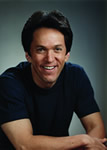
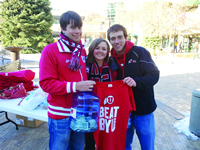

 David O’Leary BA’79 (left) is this academic year’s Beehive board president, and Joshua D. Bradley BA’98 MD’02 is president-elect. New board members (not pictured) include Ralph D. Chipman BA’75 MBA’94 MPrA’94, Stanley Langford Lloyd BS’10, John R. Macfarlane, Jr. BA’86 MD’90, and Gary K. Mangum BS’83.
David O’Leary BA’79 (left) is this academic year’s Beehive board president, and Joshua D. Bradley BA’98 MD’02 is president-elect. New board members (not pictured) include Ralph D. Chipman BA’75 MBA’94 MPrA’94, Stanley Langford Lloyd BS’10, John R. Macfarlane, Jr. BA’86 MD’90, and Gary K. Mangum BS’83. Clockwise, from top left: Kasi Goodwin is this year’s president; Sam Haslam, Becky Cannon, and Suzanne King are all vice presidents. The Student Alumni Board helps plan and organize various campus programs and events including the Utah vs. BYU Food Drive, PlazaFest, many segments of Homecoming, and a year-end party held for graduating seniors.
Clockwise, from top left: Kasi Goodwin is this year’s president; Sam Haslam, Becky Cannon, and Suzanne King are all vice presidents. The Student Alumni Board helps plan and organize various campus programs and events including the Utah vs. BYU Food Drive, PlazaFest, many segments of Homecoming, and a year-end party held for graduating seniors.
